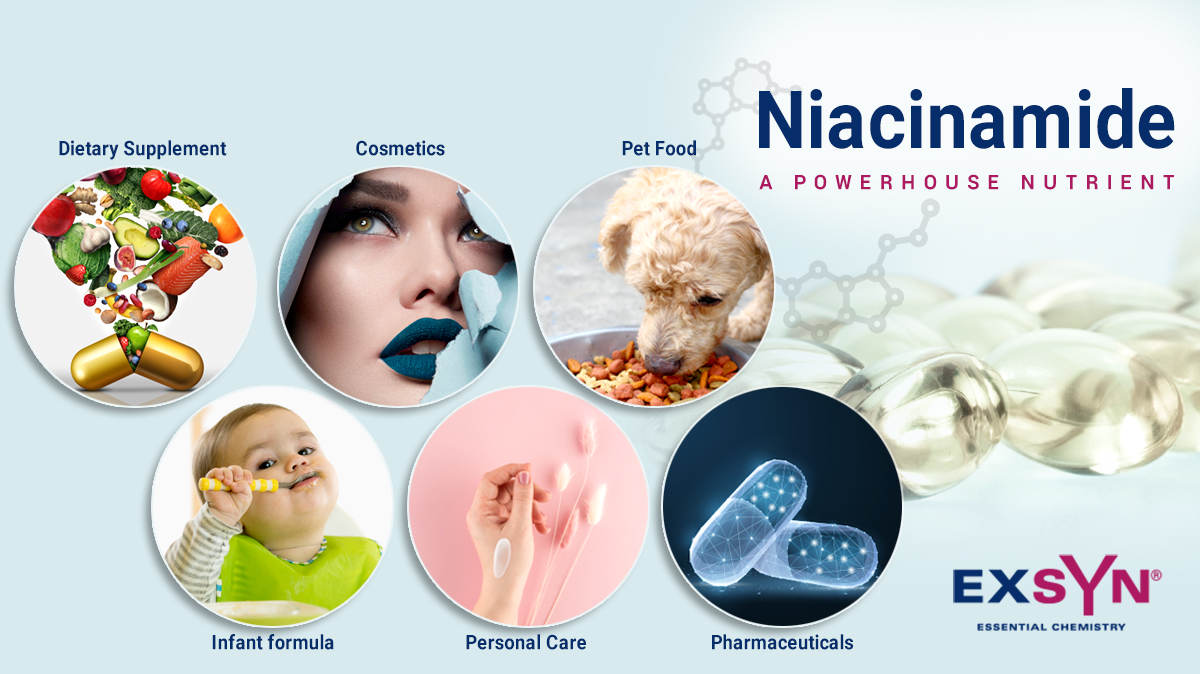INTRODUCTION
Niacinamide is a naturally occurring nutrient belonging to the pyridine carboxylic acid family. It is an important form of vitamin B3, an essential nutrient that supports many cellular processes and plays an important role in energy metabolism. Animal and refined grain-based products are fortified with Niacinamide.
It is a water-soluble vitamin that promotes release of energy from foods and enhances proper nervous system functioning. Along with systemic benefits, it also offers a wide range of topical benefits. Also, it is the preferred form of Vitamin B3 for treating Pellagra.
| Synonym | Nicotinic acid amide, Pyridine-3-carboxylic acid amide, Vitamin B3, Vitamin PP, 3- Pyridinecarboxamide, Beta Pyridinecarboxamide |
| CAS no. | 98-92-0 |
| EINECS no. | 202-713-4 |
| Chemical Formula | C6H6N2O |
SPECIFICATIONS | Niacinamide Ph.Eur
| Test | Unit | Specification |
|---|---|---|
| Appearance | – | White or almost white crystalline powder or colorless crystals |
| pH | – | 6.0 – 7.5 |
| Assay on dried substance (Chemical – Titrimetic) | – | 99.0 – 101.0 |
| Loss on Drying | % w/w | Max 0.5 |
| Unspecified impurity | % | Max 0.10 |
| Total Impurities | % | Max 0.2 |
| Sulfated Ash | %w/w | Max 0.1 |
APPICATIONS
Common applications for niacinamide are in food, feed and beverages, health and personal care and the pharmaceutical industry. Niacinamide has several other health benefits and uses as follows:
HELPFUL FOR SKIN CARE & IN PREVENTING SKIN CANCER
Niacinamide plays an important role in keeping the skin healthy. For this reason, it’s a popular additive in the cosmetic and skincare industry. When applied topically or taken orally as a supplement, niacinamide has been shown to have anti-inflammatory effects on the skin. It has been used to treat skin conditions like acne and rosacea, a facial skin disorder characterized by redness.
t is also a promising supplement which may help in preventing Melanoma which is a serious type of skin cancer that develops in the cells that produce melanin, the pigment that gives your skin its color. Owing to its role in keeping your cells healthy, oral supplements of niacinamide have been shown to enhance DNA repair in UV damaged skin in humans.
THERAPEUTIC BENEFITS / USES
Chronic kidney disease is the progressive loss of kidney function which can cause a harmful buildup of chemicals.
Research suggests that niacinamide may help decrease phosphate levels in people with kidney dysfunction by blocking its absorption. It’s been suggested that niacinamide protects and preserves the beta cells, thereby preventing or delaying the onset of type 1 diabetes in at-risk individuals.
| INDUSTRY | APPLICATIONS |
|---|---|
| Food & Beverage | Nutrient supplement in foods such as dairy, breakfast cereals & infant formulas, as an additive in beverages, energy/health drinks |
| Health & Personal Care | Used in formulations of foundations, moisturizers, skin care products, lipsticks and eye shadows |
| Pharmaceuticals | Predominantly used as a dietary supplement & vitamin supplement in health drinks and also used in antipellagra factor drug |
| Animal Feed | Nutritional supplement in animal feed as well as pet food |
REGISTRATIONS / CERTIFICATIONS
| WHO-GMP |
| FAMI-QS |
| HACCP |
| Kosher |
| Halal |
PACKAGING OPTIONS
| Bulk Bags |
| HDPE/Fibre Drums |
STORAGE
Store in a sheltered place away from sources of heat and moisture.
Niacinamide is offered by ExSyn and is available for prompt delivery. No matter the quantity you need, our exceptional quality and service will make ExSyn your supplier of choice! If you need any additional information or SDS, please get in touch with us.
Iodine is anon-metallic, dark-grey/purple-black, lustrous, solid element. It is the heaviest and the rarest of stable halogens that can be found on the crust of earth.About fifty percent of all iodine produced and manufactured worldwide is used to form Organoiodine compounds. Iodine is an important element for many health-sustaining processes and essential for human thyroid health.
The product, acronymed Oct-NBE, is an organic compound with a cyclic ring system and a 8-membered hydrophobic chain. The structure renders the chemical special properties leading to its applications in diverse fields.
Nicotine is a hygroscopic, colorless to slight yellow, oily liquid, that is readily soluble in alcohol, ether or light petroleum. It is widely used recreationally as a stimulant and anxiolytic.
The product, acronymed ETD, is an organic compound with a fused bicyclic ring system and an ethylidene group. The structure renders the chemical special properties leading to its applications in diverse fields.
Sodium perchlorate monohydrate is the inorganic compound with the chemical formula NaClO4•H2O. It is the common existence form of sodium perchlorate, which can gradually absorb water in the air to form the monohydrate. Sodium perchlorate monohydrate is white rhombic crystal which is highly soluble in water and in alcohol. Its capacity to undergo redox reactions, liberating oxygen atoms, has been harnessed in the preparation of specialty chemicals, including pharmaceutical intermediates and fine chemicals.
Triphenylphosphine is a common organophosphorus compound that is frequently abbreviated as PPh3 or Ph3P. It is widely used in organic and organometallic compound synthesis because it is an effective reducing agent as well as a neutral ligand. At room temperature, PPh3 crystals are relatively air-stable and colourless.
Potassium chlorate holds significant importance across various industries due to its diverse applications. This white crystalline compound has been utilized for centuries as an essential ingredient in the production of matches, fireworks, and explosives, owing to its ability to release oxygen upon decomposition.
Podophyllotoxin is a non-alkaloid toxin lignan extracted from the roots and rhizomes of Podophyllum species. It is an organic heterotetracyclic compound that has a Furonaphthodioxole skeleton bearing a 3,4,5-trimethoxyphenyl substituent.
Octadecylphosphonic acid (ODPA), a versatile chemical compound, serves as a surfactant and dispersant in applications spanning coatings, lubricants, and corrosion inhibition. With its hydrophobic octadecyl chain linked to a phosphonic acid group, it excels in surface modification, boosting adhesion in metal surfaces.
